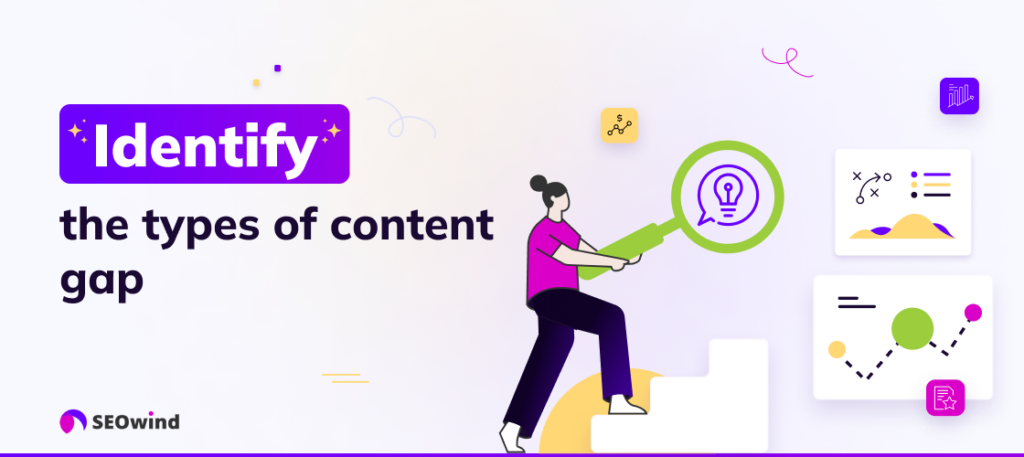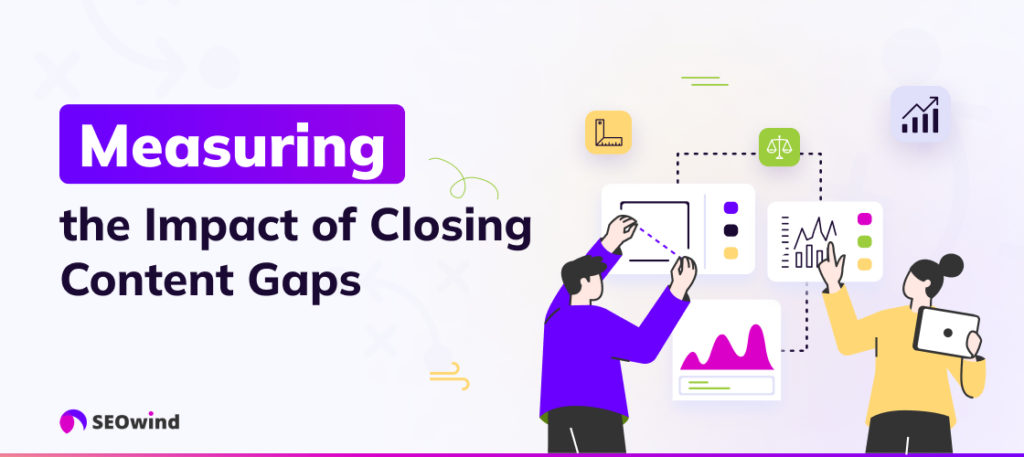Unlock the secrets of optimizing your content to enhance SEO performance with innovative strategies and game-changing tactics revealed.

Image courtesy of via DALL-E 3
Table of Contents
Introduction: What is the Content Gap?
Imagine you’re in a race, trying to reach the finish line as quickly as possible. Now, think about a website trying to reach the top of search engine results, like Google, to be seen by more people. The journey to the top isn’t just about speed; it’s also about having the right information in the right place at the right time. This is where the idea of a content gap comes in. Let’s dive into what the content gap is all about and why it’s crucial for websites to pay attention to it for better SEO.
Understanding Content
Content is like the building blocks of a website. It’s the information, articles, videos, and pictures you see when you visit a webpage. Good content is what keeps you interested and coming back for more. On the internet, content is king!
What is a Gap?
Now, think of a gap as a missing piece of a puzzle. When there’s a gap in content on a website, it means there’s information that could be valuable to visitors but is not there. This missing piece can affect how well a website does in search engine rankings.
Why It’s Important
Filling these content gaps is like completing the puzzle. When websites have all the necessary information, they become more helpful and relevant to users. This, in turn, boosts their chances of appearing higher on search engine results pages. In simple terms, filling content gaps helps websites get noticed by more people looking for what they offer.
Identifying Content Gaps
When it comes to improving your website’s visibility on search engines, identifying content gaps plays a crucial role. By understanding where your content falls short, you can strategically fill those gaps to enhance your SEO efforts. Let’s explore how you can identify content gaps in simple terms.
Using Keywords
Keywords are the specific words or phrases that people type into search engines when looking for information. By using keywords related to your topic, you can pinpoint areas where your content may be lacking. For example, if you have a website about healthy recipes but haven’t covered vegetarian options, searching for vegetarian recipe keywords can highlight a gap in your content.
Online Tools
Fortunately, there are online tools available to assist you in identifying content gaps. Tools like SEMrush or Ahrefs can provide insights into which keywords your competitors are ranking for but you are not. By analyzing this data, you can uncover valuable opportunities to create new content that fills those gaps and attracts more visitors to your site.
Competitor Analysis
Another effective way to identify content gaps is by conducting a competitor analysis. By exploring what content your competitors have on their websites, you can discover areas that you might be missing. Pay attention to topics, formats, or types of content that are performing well for them but are absent from your site. This can give you valuable insights into where you can improve and attract more organic traffic.
Creating a Content Plan
So, now that you understand what a content gap is and why it’s crucial for SEO, let’s dive into how you can create a content plan to fill those gaps with new and valuable information.

Image courtesy of seowind.io via Google Images
Setting Goals
Before you start creating content, it’s essential to establish clear and simple goals. Ask yourself what you want to achieve with your content. Do you want to increase website traffic, improve rankings on search engines, or drive more conversions? By defining your goals, you can create content that aligns with your overarching strategy.
Scheduling Content
Consistency is key when it comes to content creation. Develop a publishing schedule to ensure you’re regularly updating your website with fresh and relevant content. Whether you decide to post new articles weekly, bi-weekly, or monthly, having a set schedule will help you stay organized and maintain a steady flow of content.
Choosing Topics
When selecting topics for your content, consider what your target audience is interested in and what gaps exist in your current content strategy. Conduct keyword research to identify relevant topics that have high search volumes and low competition. By addressing these content gaps with valuable and engaging content, you can attract more visitors to your website and improve your SEO.
Writing for SEO
In order to boost your website’s visibility and attract more visitors, it’s important to understand how to write content that appeals to both search engines and readers. Let’s take a look at some key strategies for writing for SEO.
Using Keywords Properly
Keywords are specific words or phrases that people type into search engines when looking for information. It’s essential to include relevant keywords in your content to help search engines understand what your website is about. However, it’s important not to overuse keywords, as this can make your content sound unnatural. Aim to incorporate keywords naturally into your writing, ensuring that they flow seamlessly within the text.
Keeping It Simple
Clear and straightforward writing is not only beneficial for readers but also for SEO. When writing content, avoid using complicated language or jargon that may confuse your audience. Keep your sentences short and to the point, making it easy for readers to understand the information you’re trying to convey. Remember, the goal is to provide valuable and engaging content that keeps visitors coming back for more.
Linking Content
Internal linking is another essential aspect of writing for SEO. By linking to other pages on your website, you can help search engines navigate your site and understand the relationship between different pieces of content. Additionally, internal links can keep visitors on your site longer, reducing bounce rates and increasing the chances of converting them into customers or subscribers. Be strategic in your internal linking efforts, ensuring that the anchor text is relevant and descriptive.
Engaging Your Audience
Engaging your audience is a crucial part of creating content that not only ranks well on search engines but also keeps readers coming back for more. By making your content interactive and interesting, you can build a loyal following and increase your website’s visibility. Here are some strategies to help you engage your audience effectively:

Image courtesy of seowind.io via Google Images
Using Visuals
Adding pictures, videos, and infographics to your content can make it more visually appealing and easier to understand. Visuals can help break up the text, making it more engaging for readers of all ages. For example, if you’re writing a blog post about animals, including cute photos or videos of the animals you’re discussing can capture the attention of your audience.
Asking Questions
Asking questions within your content can encourage readers to think critically and engage with the material. You can pose questions at the beginning of your article to pique curiosity or use them throughout the text to prompt reflection. For instance, if you’re writing a how-to guide on baking cookies, you can ask your readers about their favorite cookie recipes to create a sense of community and interaction.
Encouraging Comments
Encouraging readers to leave comments and share their thoughts can foster a sense of community and connection. Responding to comments and actively engaging with your audience can help build trust and loyalty. Additionally, when readers feel their opinions are valued, they are more likely to return to your site in the future. For example, at the end of your blog post, you can ask readers to share their own baking experiences or tips for making the recipe even better.
Optimizing Content for Search Engines
When it comes to creating content for websites, it’s not just about writing interesting and engaging articles. Optimizing your content for search engines, like Google, is also essential to ensure your website ranks well and gets discovered by more people. Let’s dive into some key strategies to optimize your content for search engines.
Using Meta Tags
Meta tags are pieces of information that give search engines like Google details about your website’s content. They include meta titles, which are the titles that appear on search engine results pages, and meta descriptions, which provide a brief summary of your content. By optimizing your meta tags with relevant keywords, you can help search engines understand what your content is about and improve your website’s chances of being found.
Mobile Optimization
In today’s mobile-centric world, it’s crucial to ensure that your website is optimized for mobile devices. This means that your content should be easy to read and navigate on smartphones and tablets. Search engines like Google prioritize mobile-friendly websites in their rankings, so optimizing your content for mobile can have a significant impact on your SEO performance.
Fast Loading Times
Another important aspect of optimizing your content for search engines is ensuring that your website loads quickly. Search engines value user experience, and a slow website can lead to higher bounce rates and lower rankings. By optimizing images, using caching mechanisms, and choosing a reliable web hosting provider, you can improve your website’s loading times and enhance your SEO efforts.
Measuring Success
In order to know if your efforts to fill content gaps are working, it’s important to measure the success of your strategies. By using the right tools and metrics, you can track your progress and make adjustments as needed.

Image courtesy of seowind.io via Google Images
Using Analytics Tools
Analytics tools are like magic mirrors that show you what’s happening on your website. They can tell you how many people visit your site, which pages they like the most, and how long they stay. Tools like Google Analytics are easy to use and provide valuable insights into your website’s performance.
Looking at Metrics
Metrics are like the numbers on a scoreboard that tell you how well you’re playing the game. Important metrics to look at include page views, bounce rate, time spent on page, and conversion rate. These numbers can help you understand what’s working and what needs improvement.
Adjusting Strategies
Once you have analyzed the metrics from your analytics tools, it’s time to adjust your content strategies accordingly. If you notice that certain pages are performing well, you can create more content similar to those. On the other hand, if a page is not getting much traffic, you may need to rethink your approach and try something new.
Conclusion: Bridging the Content Gap for Better SEO
Now that we’ve explored the concept of bridging the content gap to enhance SEO, it’s clear that this strategy is vital for any website looking to improve its search engine rankings. By filling these content voids with valuable information, websites can attract more visitors and increase their online visibility. Let’s recap the key points we’ve covered in this article:
Importance of Content Gaps
We learned that content is the information found on websites, and a gap refers to missing or incomplete content. By identifying and filling these gaps, websites can boost their SEO and attract more organic traffic.
Identifying Gaps
Using keywords, online tools, and competitor analysis can help websites pinpoint where their content is lacking and strategize on how to fill those voids effectively.
Creating a Content Plan
Setting clear goals, scheduling content, and choosing relevant topics are essential steps in establishing a comprehensive content plan to address content gaps.
Writing for SEO
Properly using keywords, keeping content simple, and linking internally can improve a website’s SEO while ensuring readability for visitors.
Engaging Your Audience
Utilizing visuals, asking questions, and encouraging reader interaction can make content more engaging and increase user interaction.
Optimizing for Search Engines
Implementing meta tags, optimizing for mobile devices, and ensuring fast loading times are technical aspects of SEO that can improve a website’s search engine rankings.
Measuring Success
Using analytics tools, analyzing metrics, and adjusting content strategies based on data are crucial steps in monitoring and improving the effectiveness of content gap filling efforts.
By following these strategies and consistently addressing content gaps, websites can improve their SEO, increase their online visibility, and attract more visitors. Remember, a well-rounded content strategy that focuses on filling these gaps will ultimately lead to better search engine rankings and a more successful online presence.
Want to turn these SEO insights into real results? Seorocket is an all-in-one AI SEO solution that uses the power of AI to analyze your competition and craft high-ranking content.
Seorocket offers a suite of powerful tools, including a Keyword Researcher to find the most profitable keywords, an AI Writer to generate unique and Google-friendly content, and an Automatic Publisher to schedule and publish your content directly to your website. Plus, you’ll get real-time performance tracking so you can see exactly what’s working and make adjustments as needed.
Stop just reading about SEO – take action with Seorocket and skyrocket your search rankings today. Sign up for a free trial and see the difference Seorocket can make for your website!
Frequently Asked Questions (FAQs)
What is SEO?
SEO stands for Search Engine Optimization. It’s a way to improve your website’s visibility on search engines like Google. By using specific keywords and creating high-quality content, you can increase your chances of appearing at the top of search results.
How Do I Find Content Gaps?
To find content gaps, you can start by looking at what information your website currently offers and then identify areas where more content is needed. You can also use specific keywords to see what topics users are searching for but not finding on your site. By filling these gaps with relevant and engaging content, you can improve your website’s SEO.
What Tools Can Help with SEO?
There are several beginner-friendly tools available online that can assist you in improving your website’s SEO. Some popular tools include Google Analytics, SEMrush, and Moz. These tools can help you track your website’s performance, analyze your competitors, and find new keywords to target.







